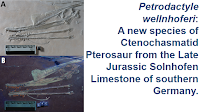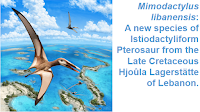Pterosaurs first appear in the fossil record in the Late Triassic, and persist till the end of the Cretaceous. During this time three basic morphotypes are found. The Rhamphorhynchoids are present from the Late Triassic till the Late Jurassic, and are considered to be a paraphyletic group from which all non-Rhamphorhynchoid Pterosaurs are descended. The highly derived Late Jurassic-End Cretaceous Pterodactyloids, are assumed to be a monophyletic group. Between these lie the Late Jurassic Darwinopterans; the Darwinopterans and Pterodactyloids are thought to comprise a single monophyletic clade, the Monofenestrata, although it is unclear if the Darwinopterans are a polyphyletic group of basal Monofenestratans from which the Pterodactyloids are descended, or whether they are a monophyletic group forming a separate branch of the Monofenestratan family tree.
Pterosaurs had delicate skeletons, made up of numerous elongate, thin bones. This is an excellent morphology for a flying Animal, but hampers the chances of that Animal's remains from being fossilised. Thus, the majority of known Pterosaur fossils come from a small number of Konservat Lagerstätten. The excellent preservation found at these sites has given us a good understanding of Pterosaur anatomy, functional morphology, and reproduction, but because their distribution in time is rather uneven, give us a rather limited perspective on the group's evolution and history. The majority of Konservat Lagerstätten date from two periods, the Late Jurassic and Middle Cretaceous, leaving us with some large gaps in which little is known about the diversity of Pterosaurs. This includes the late Early and Middle Jurassic, an interval of about 20 million years on which almost no Pterosaurs are known. The most abundant deposit from this period is the Taynton Limestone Formation of Oxfordshire, England, but the remains extracted from this deposit comprise almost exclusively isolated, and often fragmentary, bones, telling us little more than that Pterosaurs were present. Isolated Pterosaur bones are also known from the Oxford Clay, albeit in lower abundance. Fragmentary remains are also known from Kyrgyzstan, Mongolia, and China during this interval, though deposits from Argentina and China previously thought to have been of Middle Jurassic origin, from which a number of Pterosaur have been described. have recently been re-evaluated as being younger or older.
In 2022 a Middle Jurassic Rhamphorhynchine Pterosaur, Dearc sgiathanach, was described from the Isle of Skye, Scotland, and in 2023 a partial non-Pterodactyloid Pterosaur was described from the same location. These, along with a possible Aurognathid from Mongolia, are currently the only known articulated Pterosaur skeletons from the Middle Jurassic.
In a paper published in the Journal of Vertebrate Paleontology on 5 February 2024, Elizabeth Martin-Silverstone of the Palaeobiology Research Group at the University of Bristol, David Unwin of the Centre for Palaeobiology and Biosphere Evolution and School of Museum Studies at the University of Leicester, Andrew Cuff of the Human Anatomy Resource Centre at the University of Liverpool, Emily Brown of the Fossil Reptiles, Amphibians, and Birds Section at the Natural History Museum and the School of Geography, Earth & Environmental Sciences at the University of Birmingham, Lu Allington-Jones of the Conservation Centre at the Natural History Museum, and Paul Barrett, also of the Fossil Reptiles, Amphibians, and Birds Section at the Natural History Museum, describe a new species of Darwinopteran Pterosaur from the Middle Jurassic of the Isle of Skye.
The new species is named Ceoptera evansae, where 'Ceoptera' derives from 'cheò' or 'ceò' (pronounced ‘ki-yo’) the Gaelic word for 'mist', in reference to the Gaelic name for the Isle of Skye, Eilean a’Cheò, or Isle of Mist, and '-ptera' the Greek for 'wing', and 'evansae' honours Susan Evans of University College London, 'for her many years of anatomical and paleontological research, in particular on Skye', and for introducing Martin-Silverstone et al. to the locality where the specimen from which the species is described was found.
Ceoptera evansae can be distinguished from all other Pterosaurs by two features: (1) the presence on the distal (sternal) portion of the coracoid shaft of a well-developed, elongate, narrow, sub-rectangular bony flange (probably a site for insertion of the sternocoracoideus muscle) with an irregular ‘wavy’ free margin, which extends proximally for almost one-quarter of the length of the coracoid; and (2) the lateral surface of the posterior, dorsally expanded, portion of the post-acetabular process of the ilium bears a prominent depression divided in two by a low, rounded vertical ridge.
Ceoptera evansae is calculated to have had a wingspan of about 1.6 m. Determining the maturity of Pterosaurs can be difficult, as the order in which the fusion of bones occurred seems to have been highly individualistic, often not following the same pattern in members of the same species. Nevertheless, the pelvic plates, syncarpals, and tibia-fibula of Ceoptera evansae are fully fused, probably indicating that this was a mature individual.
A phylogenetic analysis was carried out including Ceoptera evansae along with previously described Pterosaurs. This recovered the Darwinoptera as a monophyletic clade, forming a sister group to the Pterodactyloids, although this is not yet sufficiently statistically strong to assume that later discoveries will not change this reconstruction.
Ceoptera evansae is the fourth known articulate Pterosaur from the Middle Jurassic, and the second described species. The interpretation of Ceoptera evansae as a member of the Darwinoptera shows that this group was not, as was implied by the previously available evidence, restricted to the Late Jurassic of East Asia, but had a much wider distribution both geographically and chronologically. Furthermore, the addition of Ceoptera evansae to the Pterosaur phylogenetic tree implies that the Darwinoptera are not simply a polyphyletic basal group of Monofenestratans, but rather a distinct clade forming a sister taxon to the Pterodactyoidea.
See also...













